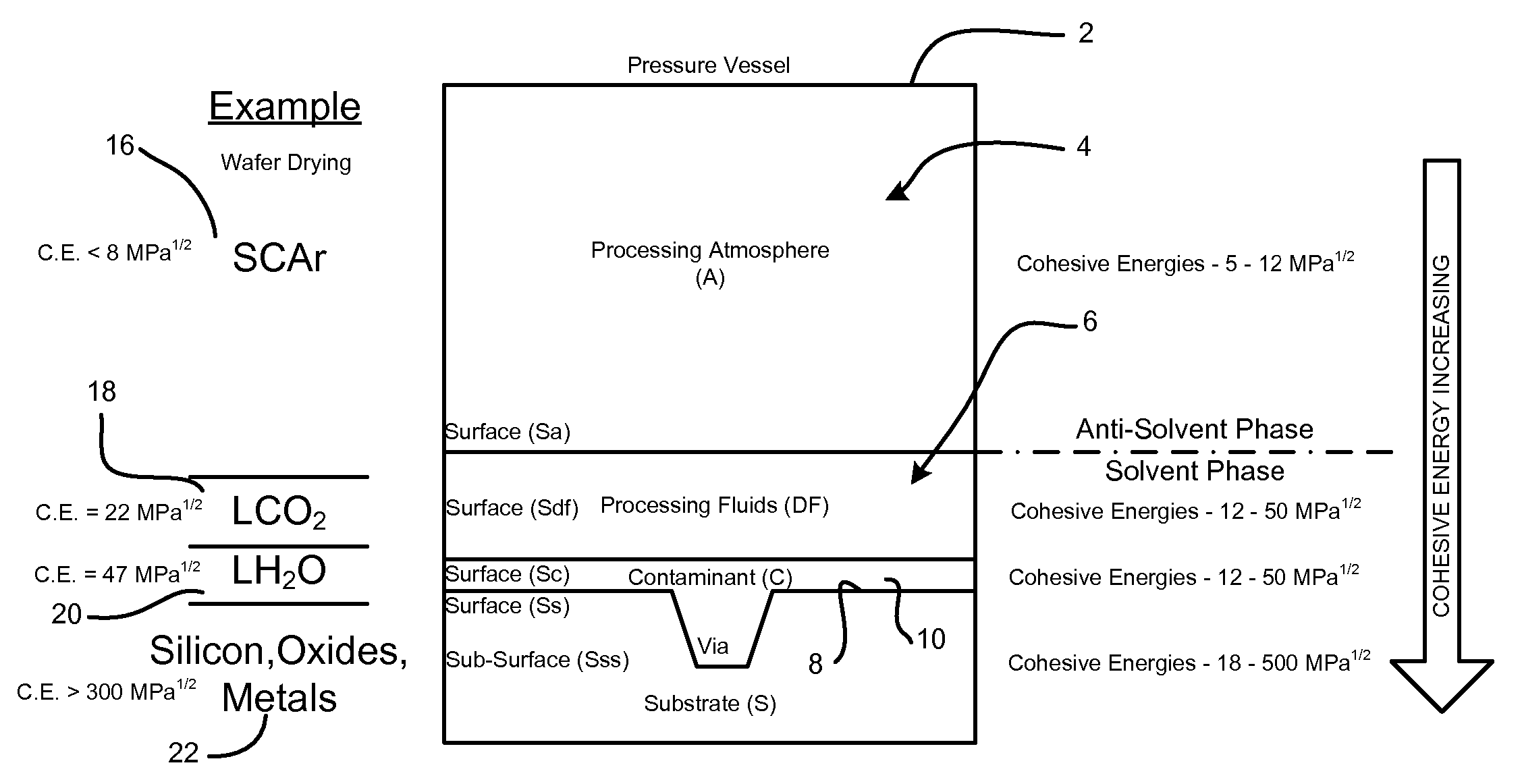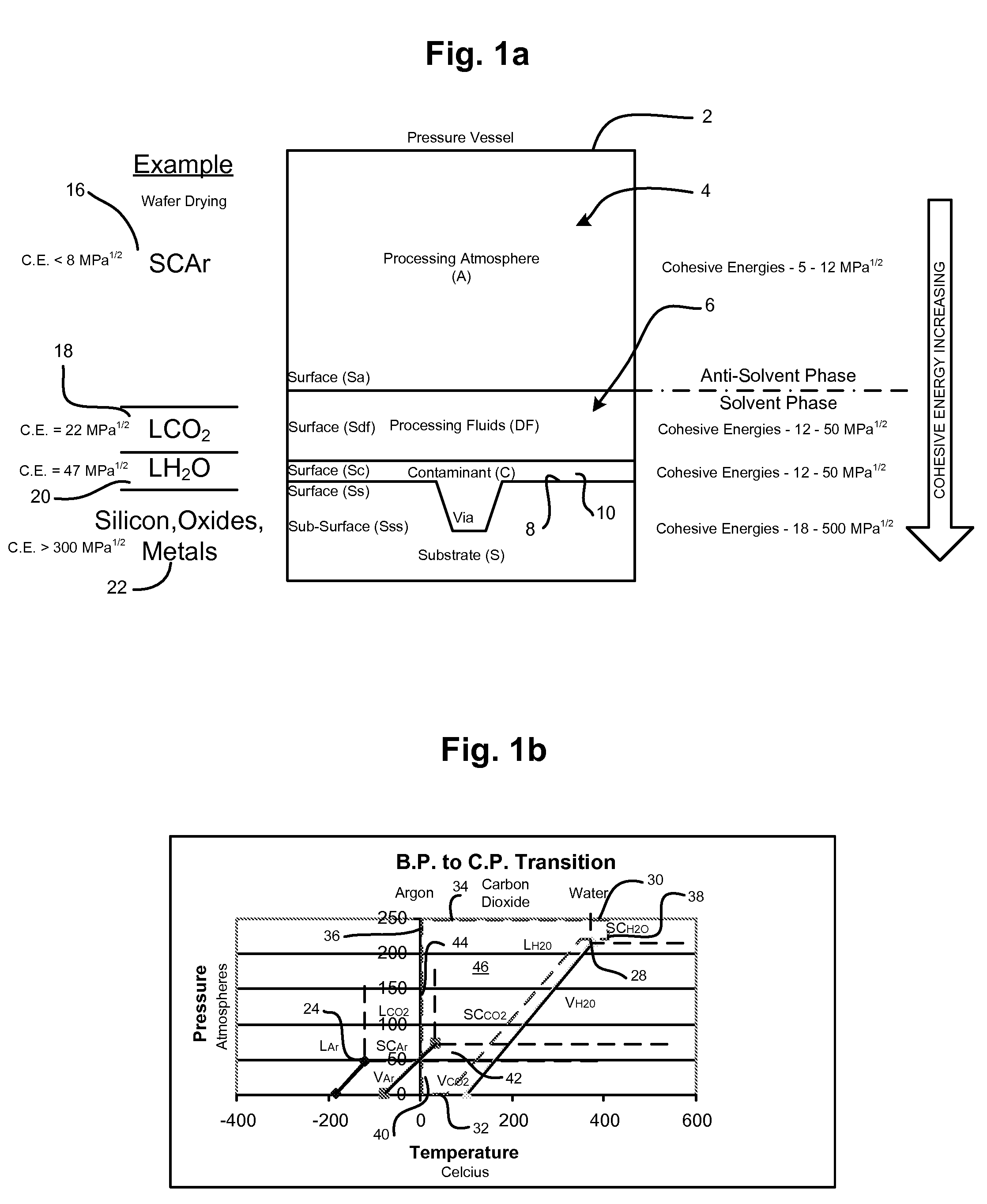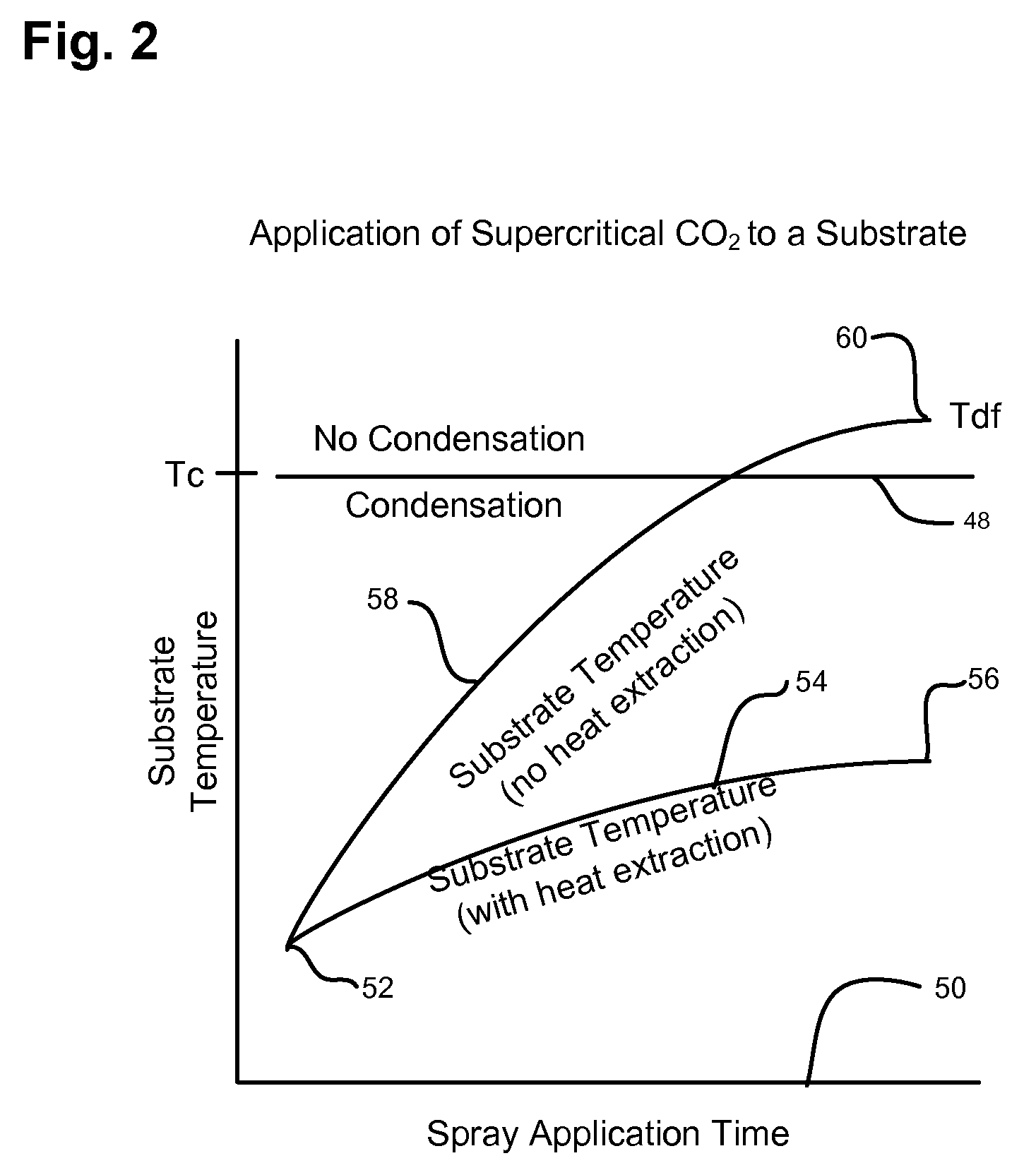Smaller circuits and surface features are becoming increasingly affected by smaller surface particles and other residues (contaminations) during
manufacturing operations.
Moreover, many conventional
wet cleaning techniques are not compatible with the shrinking device geometries and new manufacturing materials.
The presence of organic contaminants or particles on a
substrate surface with thicknesses on the order of 0.1 microns or greater generate considerable cleaning difficulties.
For example, the smaller dimensions create new cleaning challenges due to increasing capillary force pressures which hold process fluids within cavities, more prevalent electrostatic forces which hold micromechanical structures together, porous or complex surface
topography which preclude the use of aqueous chemistries, and high
aspect ratio cavities and vias which hide etch residues and particles, among others.
Moreover,
new materials such as low-k films and
copper lines used to fabricate smaller device geometries (line widths) are not compatible with many conventional wet
processing techniques described above.
However, the compliant nature of the
silicon makes it susceptible to fabrication problems.
A significant problem in the fabrication of the micromachined components is sticking of released structures to the substrate after they are dried using conventional
air drying techniques.
Electrostatic forces due to electrostatic charging may cause sticking.
This is a non-equilibrium condition which usually dissipates over time or with contact between conducting surfaces.
The impurities in narrow gaps formed by the suspended microstructures essentially bridge the gaps, causing the structures to stick.
Perhaps the most troublesome cause of surface
stiction is liquid bridging.
Interfacial forces generated when the trapped capillary fluid dries can cause the microstructures to collapse and stick.
Moreover, conventional thermal or
solvent drying of
silicon IC structures such as microvias cause the cavity walls to crack as the sidewalls are pulled together during extraction or
evaporation of water or
high surface tension drying solvents such as methyl
alcohol.
If a liquid such as water is present in small capillaries during the drying process, the
surface tension exerts tremendous pressure on the sidewalls.
This stress can be high enough to cause smoothe flat interfaces to stick, or in the case of IC fabrication,
microvia sidewalls to collapse.
The most significant drawbacks with the aforementioned conventional dense fluid drying techniques are very long process cycle times and the use of excessive amounts of supercritical or
liquid carbon dioxide in completely flooded pressure vessels to remove only
trace amounts of surface
contamination (i.e., water and drying solvents).
Another drawback is that these drying methods do not effectively remove
small particles and in fact can easily re-contaminate substrates which are completely bathed in the reactor fluid.
Moreover, these methods are not effective or selective for removing other liquid contaminations present on the substrate surface or trapped within pores of substrates.
Still moreover,
solid contaminants such as carbon residues are not effectively removed using these conventional techniques, even when modified with organic solvents.
Most often extreme pressures are required to achieve separation.
If left on critical surfaces, these may bridge circuits, obscure light or produce other deleterious side-effects which reduce yields, that is clean dry surfaces for subsequent
processing steps.
Moreover, processes described above such as cleaning,
etching, drying and application of coatings are most often performed as separate operations, which greatly increases the risk of device
contamination during manufacture.
However, similar to the DIO3 process, transport of
ozone of any significant concentration into micron features on the
wafer surface is very limited due to the solid-ozone gas interface.
Moreover excessive agitation caused by rapid movement of water over the
spinning wafer accelerates the
decomposition of the ozone gas as it diffuses through the thin film boundary.
Moreover, complete drying of the substrate following cleaning by both methods is also limited due to hydration of small capillaries, vias and interstices present on the wafer.
Finally, a lack of solvent selectivity can be limiting in many
resist removal applications.
A limitation with this method is its inability to actually remove particles from the wafer.
In fact, the rapid deployment of water from the tank often transfers more particles onto the wafer.
In addition, the wafers from the quick dump tank must still undergo a drying operation, further increasing the number of particles on the wafer.
However, the spin rinse / dryer often introduces more particles onto the wafer.
A further limitation is
static electricity often builds up on the wafers during the spin cycle, thereby attracting even more particles onto the surface of the
semiconductor.
Accordingly, the spin rinse / drying does not clean or remove particles from the wafer.
This superheated or saturated drying vapor often requires the use of large quantities of a hot volatile organic material.
A limitation with this type of dryer is its use of the large solvent quantity, which is hot, highly flammable, and extremely hazardous to health and the environment.
Another limitation with such a dryer is its cost, which is often quite expensive.
However, hot water often produces stains on the wafer, and also promotes build-up of bacterial and other particles.
This is a significant
disadvantage as elevated temperatures improve spray cleaning performance, lowering
particle adhesion and increasing contaminant
solubility, and increases the solubility of high molecular weight polymers such as
photoresist resins.
For example, the
liquid phase carbon dioxide
surface tension, density and
viscosity in the '936 patent cannot be varied to any significant degree, which prevents optimization of solute
chemistry and substrate cleaning and deposition processes.
Moreover, the substrate is contained in the saturated dense fluid vapor
atmosphere which requires large quantities of dense fluid and extra
processing steps to remove.
Using this method, most of the cleaning fluid is wasted and cross
contamination problems arise.
As discussed above in regard to the '936 patent, the '510 patent suffers from lack of selectivity, with the entire substrate processed in essentially carbon dioxide.
The '510 patent does not teach creating reactive cleaning agents in-situ nor selectively applying said instantaneous cleaning agents to contaminated surfaces to achieve a desired substrate surface cleanliness in a much more rapid period of time.
The process of the '366 patent is inefficient because it changes the properties of an entire fluid environment to process a substrate surface.
Also the '366 patent will not remove small surface particles because it does not produce sufficient
shear stress energy during the
phase transition.
The process of the '366 patent is inefficient because it changes the properties of an entire fluid environment to process a substrate surface, causing the
coating to coat all surfaces of the reactor and substrate simultaneously.
Moreover, the prior art does not propose the novel and beneficial aspects of combining plasmas with dense fluids.
Though this can be advantageous for organic removal from
ion sensitive components it also produces a less homogeneous process resulting in the compromising of uniformity across the work area.
In
surface modification the
effective depth of the modification is tens of nanometers so the uniformity of the process becomes increasingly important, rendering MW source plasmas a less desirable choice.
A major problem that prevents adequate adhesion is the presence of organic contamination on the surface.
The reaction is by its nature complete with no residual surface products, however non-organics such as salts are not so readily removed.
Lower power densities not only remove contamination at a slower rate but also can actually impede the removal process.
Large irregular surfaces also can be treated with little possibility of over-treatment, a drawback of both
flame and
corona methods.
Even the best stainless steel has been known to oxidize in a
plasma environment and over time the oxidized surface can be a source of undesirable particulate.
Thus, it has a tendency to adsorb particulate and organic contamination from the ambient environment.
This may lead to non-uniform coatings, in particular if deposited from liquid media.
Crosslinking of thick films of organic contaminants such as oils will hinder cleaning action because it creates a barrier (i.e., carbon) to subsequent
plasma reactions.
Dense fluid
plasma technology enables new surface treatment possibilities not possible using either technology alone.
If the
rotation velocity is in a range, that the atmospheric friction leads to high Reynolds numbers (turbulences), disturbances in the
coating quality are observed.
Spin coating and spin cleaning technology as practiced by the present inventor and others using dense fluids as noted herein suffer from a lack of control of the various surfaces such as
atmosphere-dense fluid-substrate and other factors such as drag force,
viscosity, fluid chemistry and surface chemistry—all of which are major components in optimizing and controlling the production of thin or thick films and coatings and removing undesirable substances from surfaces.
The water left absorbed on such surfaces and edges often attracts and introduces more particles onto the
semiconductor wafer and is a outgas and adhesion contamination in subsequent
photoresist deposition following cleaning and drying operations.
The aforementioned conventional techniques fail to provide such desired features, thereby reducing the die yield on the
semiconductor following optical printing or lithographic processes.
 Login to View More
Login to View More 


